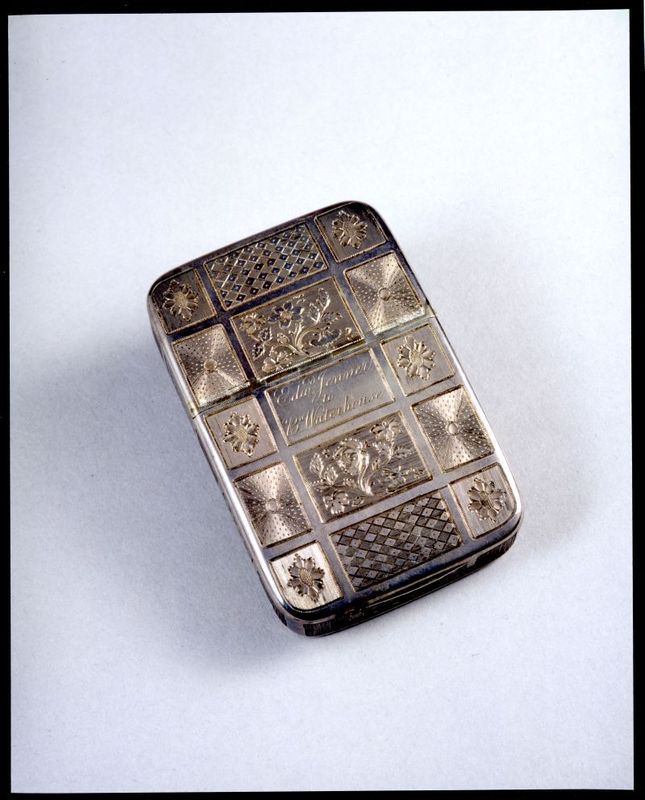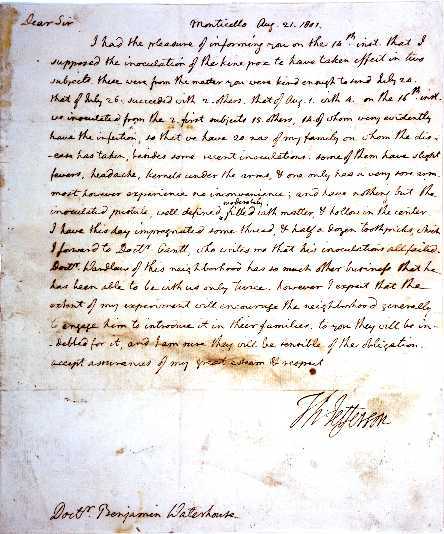1801-1851
This silver snuffbox was a gift from English physician Edward Jenner (1749-1823) to Benjamin Waterhouse of Cambridge. In 1796, Jenner discovered that cowpox vaccine could be introduced into the human body to produce immunity to smallpox. Benjamin Waterhouse (1754-1846) played a major role in the introduction of Jenner's work into this country by performing the first smallpox vaccinations on his children during the summer of 1800. The two physicians became correspondents and friends.
In a letter dated November 16, 1802, Waterhouse said, "Dr. Jenner has been to me what the sun is to the moon…. Dr. Jenner has just sent me a present I highly prize, a silver box inlaid with gold of exquisite taste and workmanship, bearing the inscription, 'Edward Jenner to Benjamin Waterhouse.' But Mr. [John] Ring annexed the superscription in rather a hyperbolic style, 'From the Jenner of the Old World to the Jenner of the New World.'"
After successfully vaccinating his son, Daniel, against smallpox, Benjamin Waterhouse sent a copy of his pamphlet A Prospect of Exterminating the Small-Pox (1800) to Thomas Jefferson, then Vice-President of the United States. Jefferson was keenly interested in Waterhouse’s work, responding that "Every friend of humanity must look with pleasure on this discovery, by which one more evil is withdrawn from the condition of man…. In this line of proceeding you deserve well of your country." Benjamin Waterhouse and Thomas Jefferson then corresponded on the subject for a number of months.
As this letter from 1801 testifies, some vaccine matter from Waterhouse was used by Jefferson in experiments with members of his family and household at Monticello. The President then promoted the use of smallpox innoculation in other cities of Virginia, gave some of his vaccine to Dr. John Redman Coxe to begin work in Philadelphia, and even sent some sample matter with explorers Lewis and Clark to encourage the spread of vaccination throughout the country.
English artist and caricaturist George Cruikshank was one of the foremost illustrators of the Regency and Victorian periods. Over the course of his career, he produced some 15,000 drawings and illustrated 850 books, including Charles Dickens’ Oliver Twist and Sketches by Boz. Specimens of George Cruikshank’s famous Phrenological Illustrations (1826) and his temperance tracts, The Bottle (1847) and The Drunkard’s Children (1848), can all be found in the Countway Library’s print collection. This less familiar illustration, a representation of an excruciating headache, forms part of a medical series showing the torments inflicted by the demons of colic, depression, jealousy, and indigestion.
English explorer Sir John Franklin, his two ships, and 128 crewmen vanished during a voyage to discover the Northwest Passage in 1845 and became one of the great mysteries of the 19thcentury. Many rescue missions were launched over the next fifteen years to search for survivors. This diary from Benjamin Vreeland, a U.S. Navy surgeon and member of the First Grinnell Expedition of 1850, documents in vivid detail the hardships and experiences of the crew of the Rescue and her companion ship, the Advance, during a sixteen-month voyage into the Arctic regions looking for Sir John Franklin.
In this passage from August 27, 1850, Vreeland recounts the discovery of the graves of three of Franklin’s sailors on Beechy Island, in the Canadian Arctic. Although the mystery of the loss of the Franklin Expedition has never been completely solved, the Rescue and the Advance were the first ships to return to the United States with news of the expedition’s probable tragic end.


